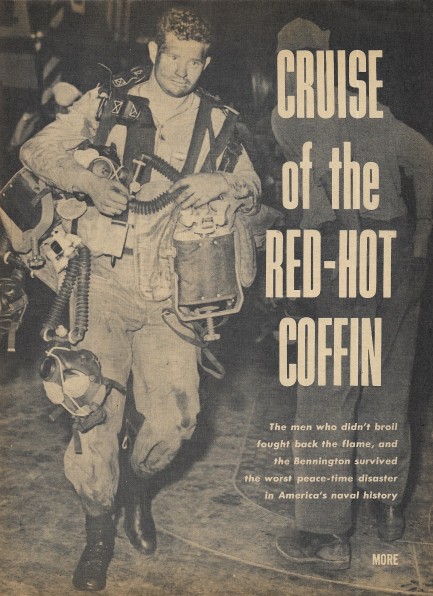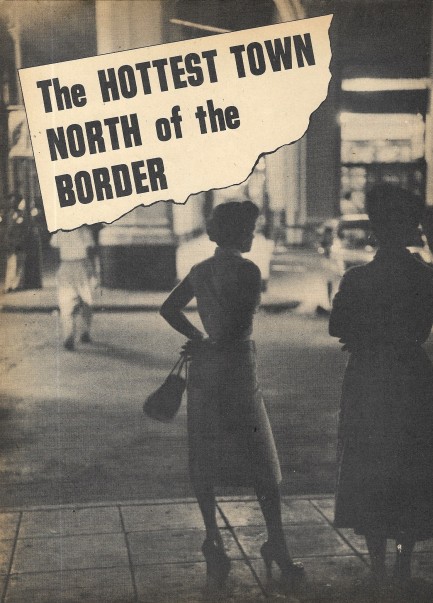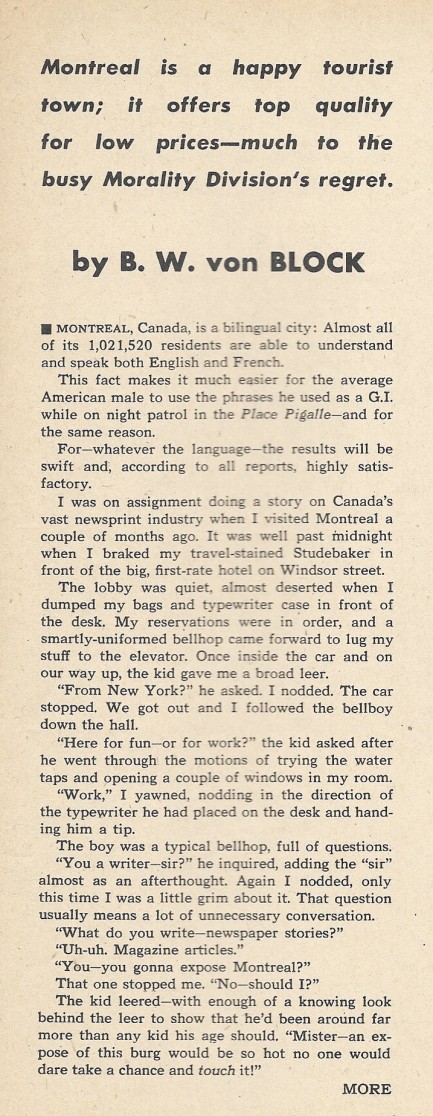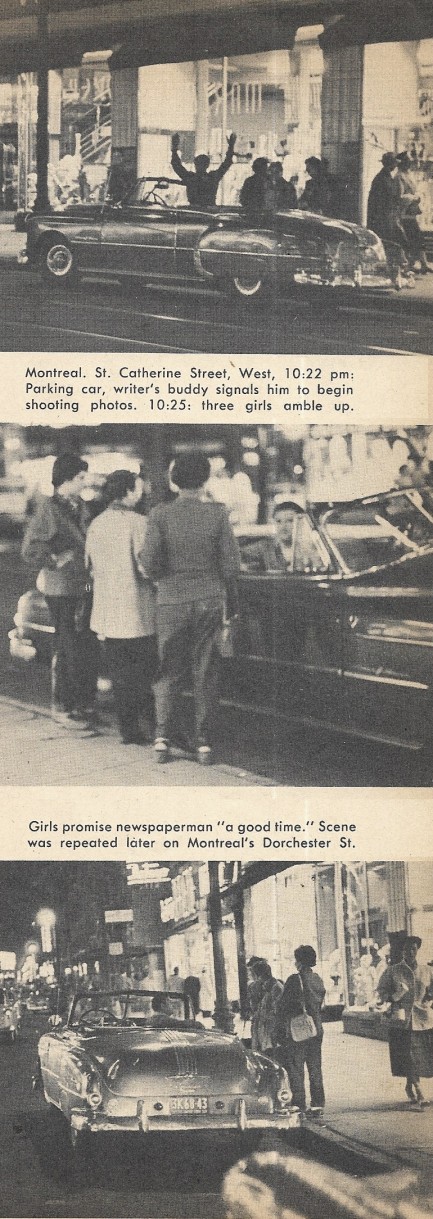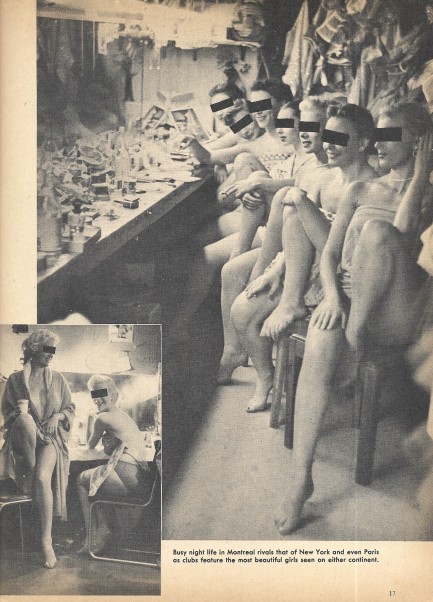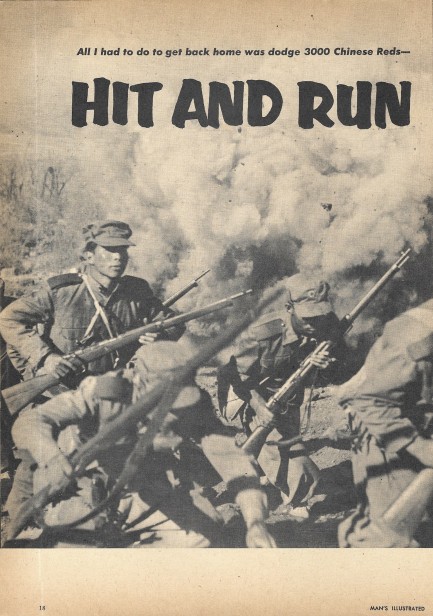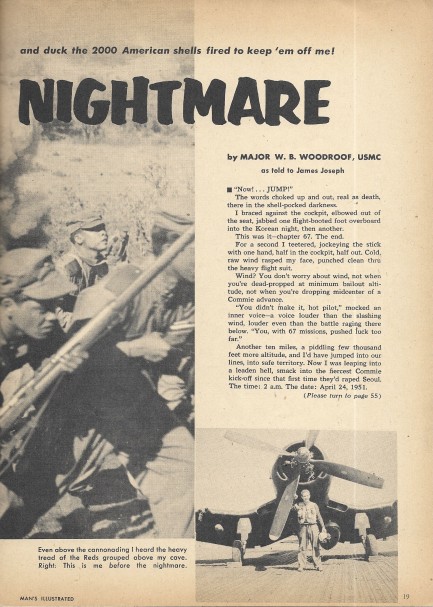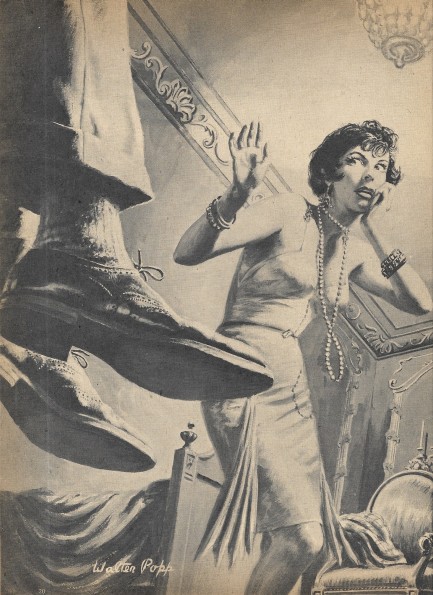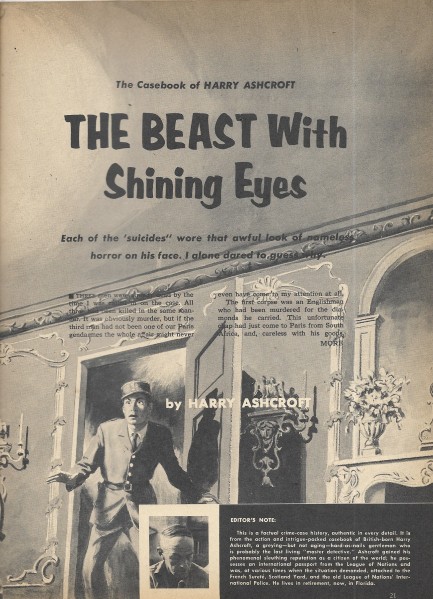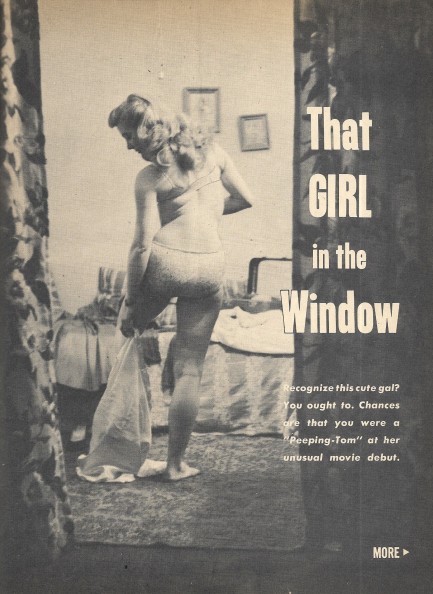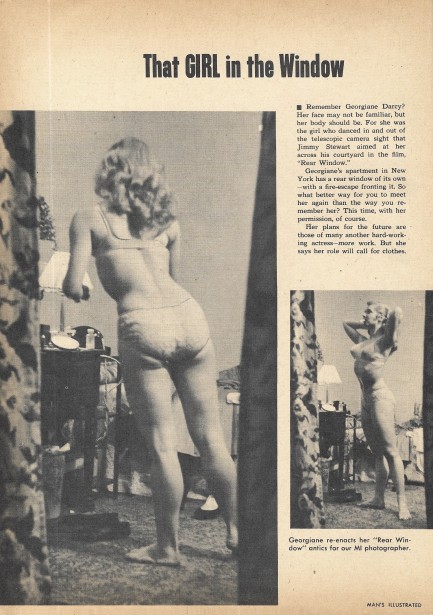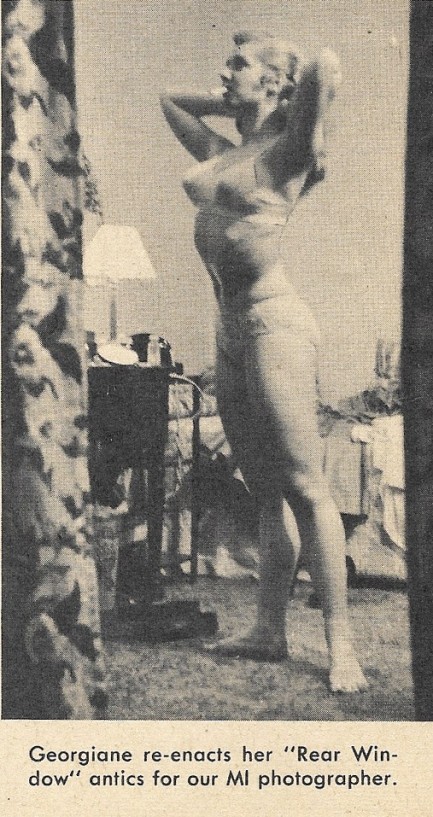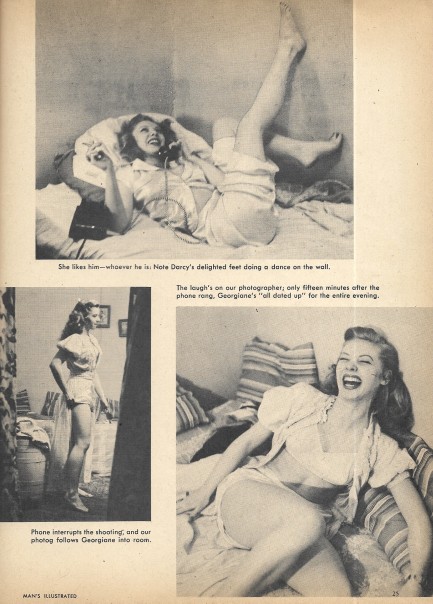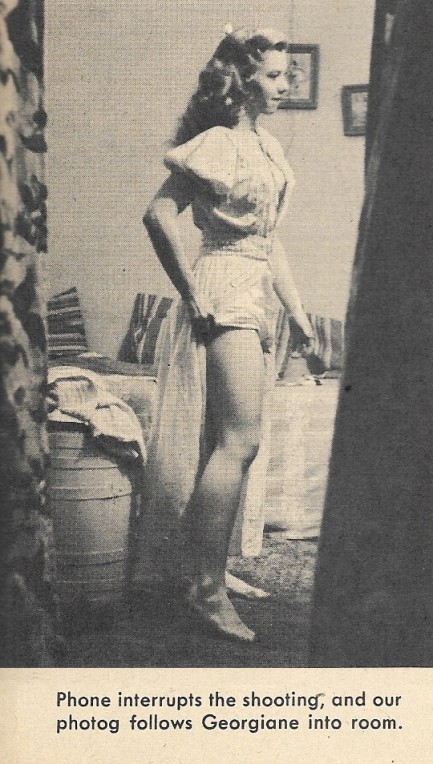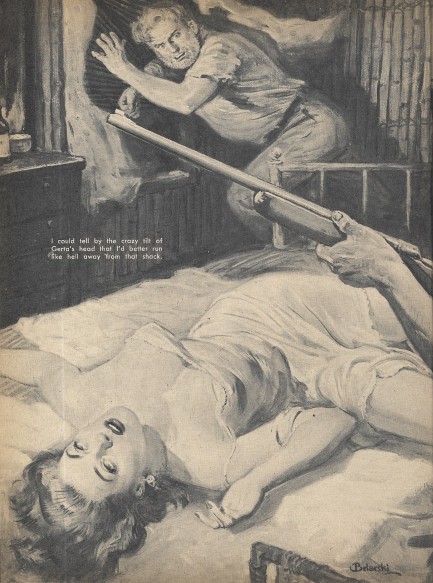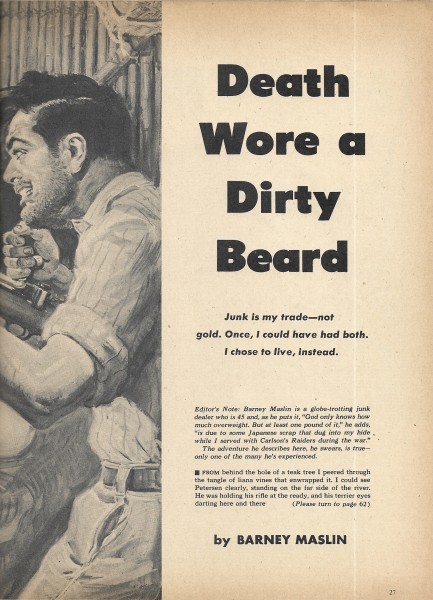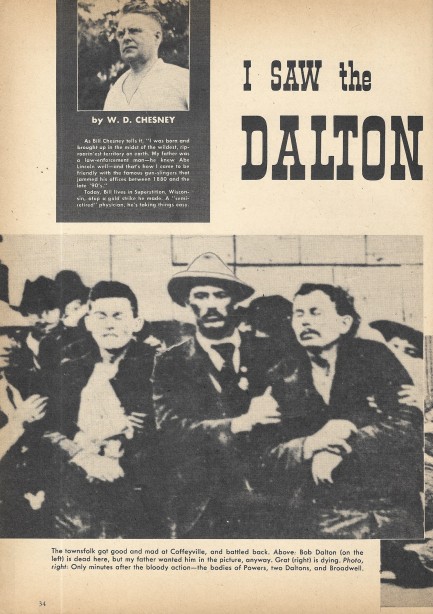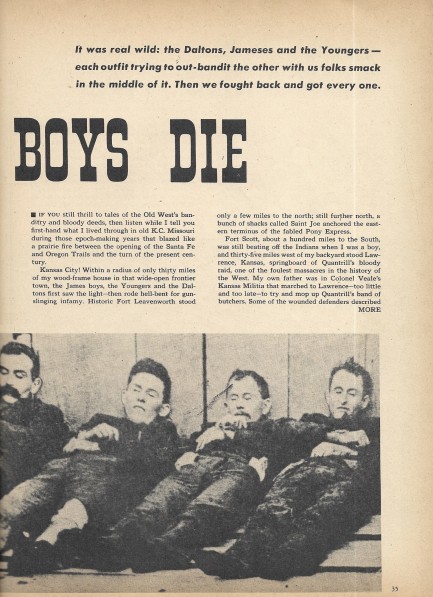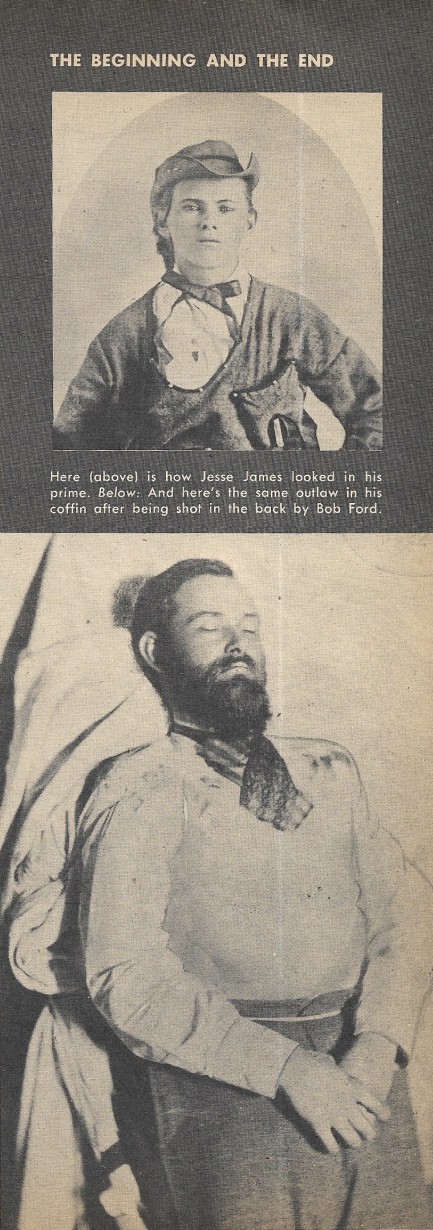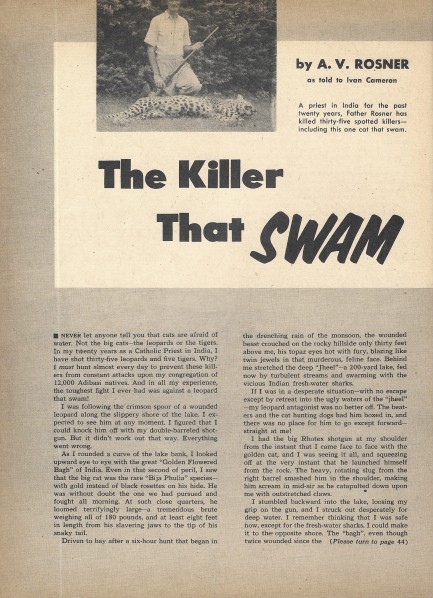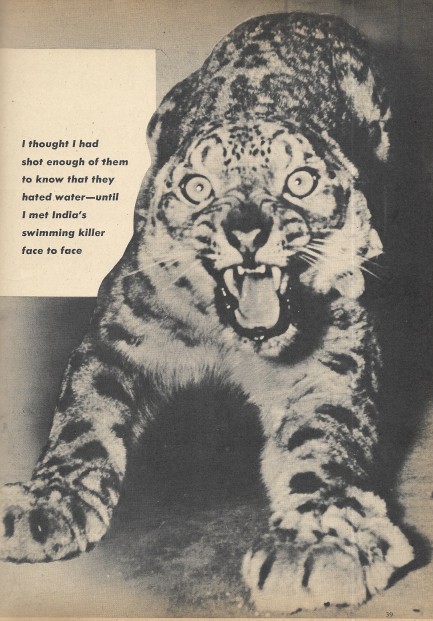| Vintage Pulp | May 22 2024 |

You can go up if you guess what number I'm thinking. Hint: it has a dollar sign before it and two zeros after.
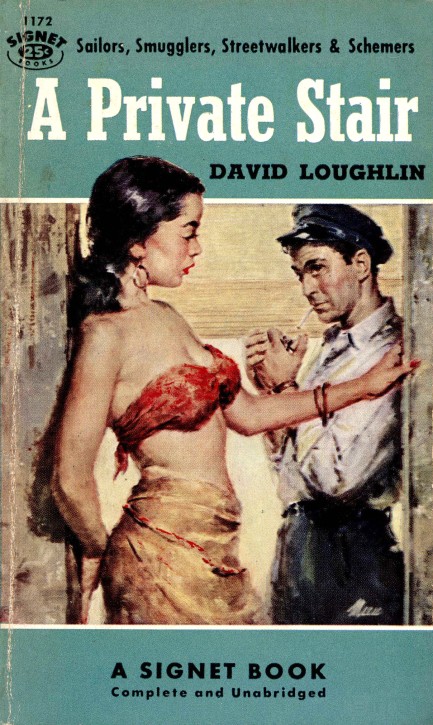
Above: more nice work from illustrator James Meese, this time for David Loughlin's novel A Private Stair. It originally appeared in hardcover in 1950, with this Signet paperback edition coming in 1956.
| The Naked City | Feb 4 2024 |

Take a picture, perv. It'll last longer.


Above is another striking image from the 2019 Lucie Foundation exhibit of Los Angeles crime photos, most of which have been widely disseminated across the internet since then. That means we can always grab one when we want to dip into the mid-century crime underworld. The subject here, with her unfliching gaze and lit cigarette, has been arrested but there's no info revealing why. We're thinking public check and pinstripe clashing? No, probably not that. Imitating Sharon Stone in Basic Instinct? No, that was before her time. Felony cruelty to fur-bearing mammals? No. Okay, here's a shot in the dark—probably she was arrested for prostitution. That's our final guess. The photo was made today in 1949.
| Vintage Pulp | Nov 11 2023 |

She's always there when you need her, but who's there for her?
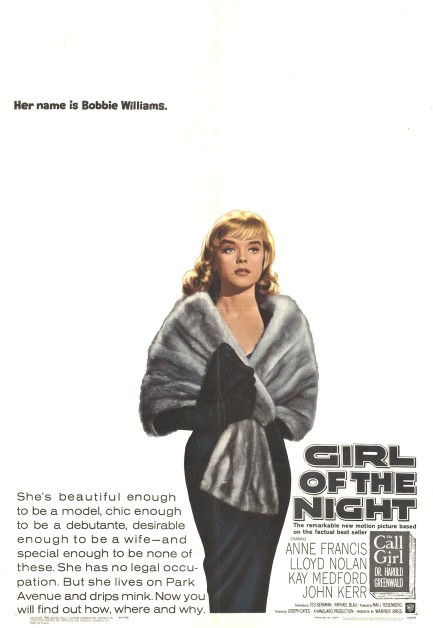
For years we've been eyeing this awesome promotional poster for the Anne Francis prostitution drama Girl of the Night and always meant to get around to watching the movie. Mission accomplished, finally. The film premiered today in 1960 and was based on The Call Girl, a bestselling book by psychologist Harold Greenwald that began as a doctoral dissertation about prostitutes. We gather it focused on the rationalizations women used to distance themselves from or compartmentalize the work. We wonder if it's outdated by now, but at the time the book was a sensation.
Francis plays Bobbie Williams, a call girl whose bad night causes her to begin talking with a therapist in her building. The movie takes the form of a couch confessional with flashbacks, as we learn about Francis's circumstances, and particularly about the two people—basically a pimp and madame—who conned her into the racket. As the therapy progresses we learn more about her past, including the delivery man who—this part is obviously vague considering the time period—either molested or raped her when she was a child.
With help maybe Francis can break loose from her cage, but it won't be easy. She's emotionally dependent on her pimp, and because she has no job skills freedom looks like another form of imprisonment. We thought all of this was pretty well done. Make no mistake—this movie is a melodrama, but it kept us interested, and that's entirely to the credit of Francis. She's best known these days for her virginal turn in 1956's Forbidden Planet, but she had range, and shows it as the burned out prostitute at the center of the film. For her performance alone, we recommend Girl of the Night.
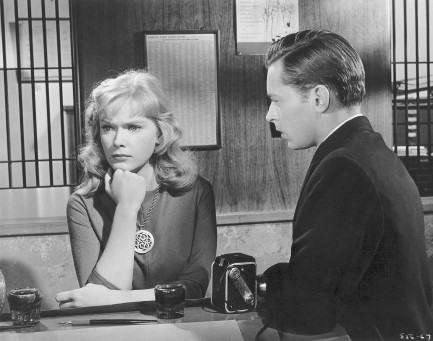
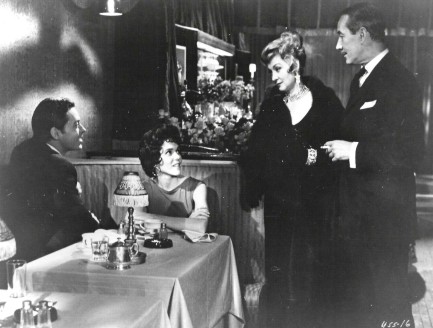
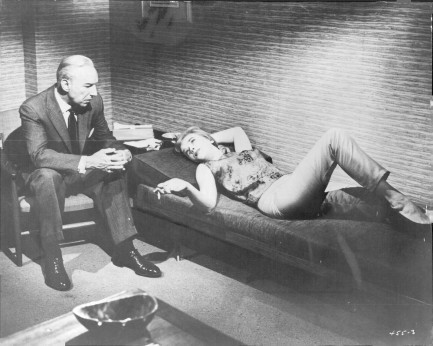

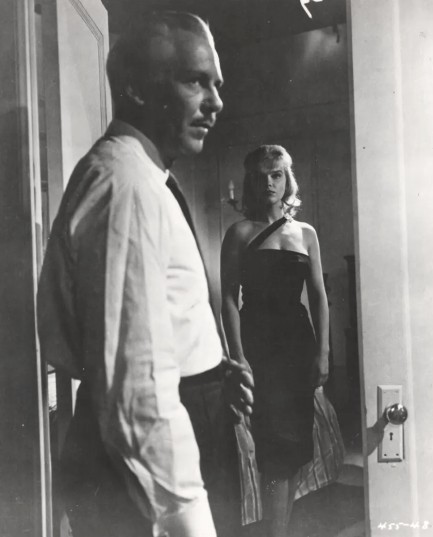
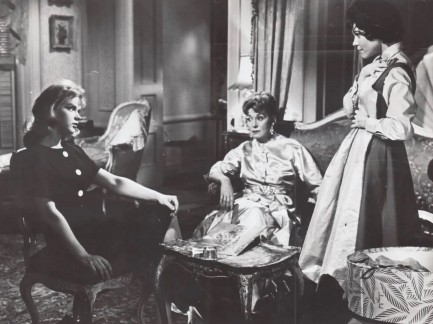

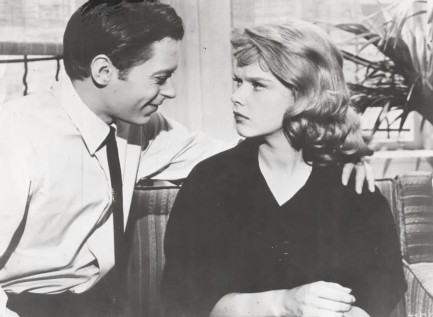
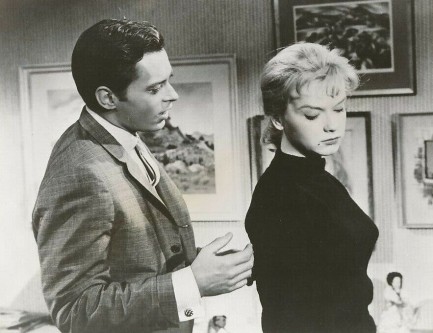
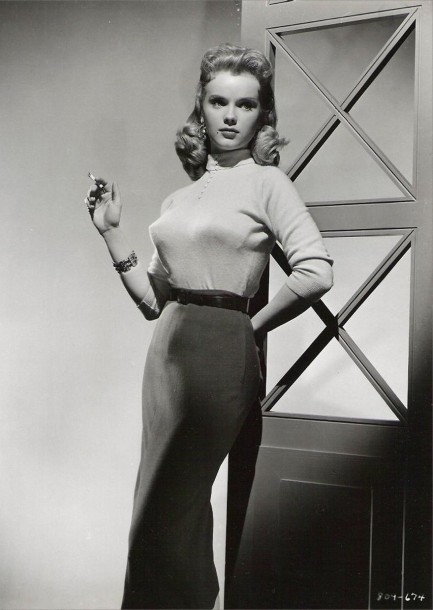










| Intl. Notebook | May 8 2023 |

National Bulletin's fake cover story was unconscionable even in 1972.
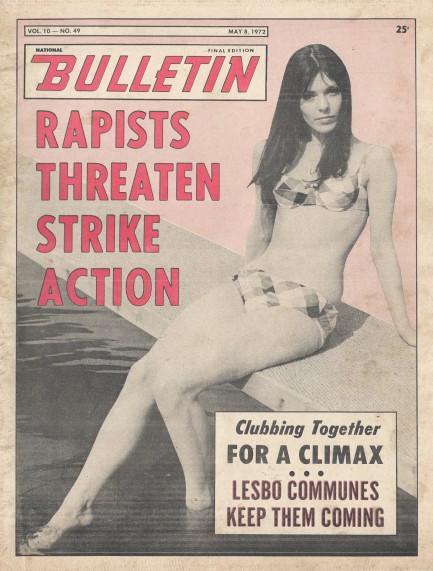
This issue of National Bulletin published today in 1972 features a cover touting rapists going on strike. Do we have any doubt that this sprang from the brows of middle-aged editors with smoker's coughs, fallen arches, and no dates? As we've documented before, cheapie tabloids often trafficked in such imaginary stories. This one is akin to comedy—unamusing, tone-deaf comedy. The gist is that the head of RUFF—the Rapist's Union for Fun and Frolics—says raping women isn't fun anymore because they're too liberated and actually enjoy it. It would have been crude already in 1972 (that's why the editors did it), but these days such sentiments send a cringe through the deepest recesses of your body. The honchos at National Bulletin would, of course, say they're just riffing, yet the fact that the idea was considered by them to be viable as humor still says so much. And what it says isn't good.
So why share such items? Well, we're mainly interested in the art and graphics of old paperbacks and movie posters, and the rare photos of celebrities found in period tabloids. There are starphotos in these publications that literally don't exist online until we upload them. As lovers of old Hollywood, it's mandatory that we do so. But also, in our view, it's important to document vintage social attitudes. And here's why—after enough time passes it's easy for bad faith entities to pretend such beliefs never existed. Sharing these tabloids reminds us both of where we came from, and where we're going. In terms of promotional art and aesthetics, we believe we've ended up someplace worse than before—no matter how many book design awards are given to whichever Photoshopped covers of whatever year. Conversely, in terms of social development, we believe things are generally—despite an eddy of a few years or a decade here or there—improving.
So we're presented with divergent movement—trains traveling in opposite directions on parallel tracks during the mid-century era. On one track is excellent and commemorable visual content, and on the other is a set of social attitudes with which we tend to disagree. While it's true we could separate the art from its context, we think that's a bad practice. Many of the emails we've gotten from students, researchers, filmmakers, writers, and history buffs curious about these magazines indicate to us that without context, understanding the true characteristics of art is impossible. It'd be like looking at Picasso's “Guernica” without knowing there was such as thing as the Spanish Civil War. Yeah, it's still a great painting. But knowing its political genesis makes it more interesting. Knowledge is armor.
Bulletin moves on from the fictional rape story to offer up slightly less horrible fare in its other pages. Readers learn about lesbian communes, consensual bondage, prostitute conservationists, and sexually depraved athletes. Editors also tell readers Americans are losing the “sex race”—i.e. formerly virile men are becoming weak and impotent. If you're thinking you've heard similar masculine moaning on modern cable television, you'd be right, but the sad difference is that Bulletin's story is meant to be farce, whereas modern cable news is deadly serious about “feminization.” Accompanying the text is a photo of a woman taking the pants off a smiling wax figure of Richard Nixon. That is legitimately funny. We've enlarged it below. Feel free to spread that marvelous image far and wide. More tabloids to come.


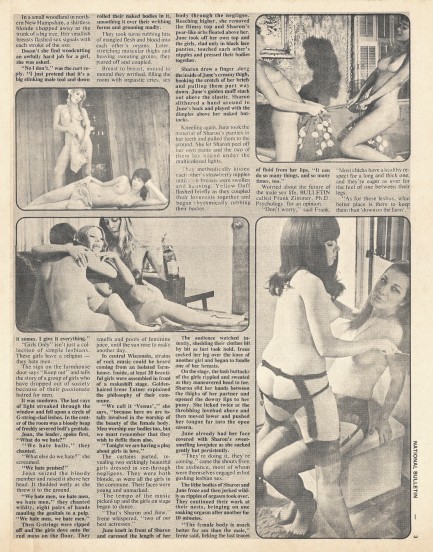
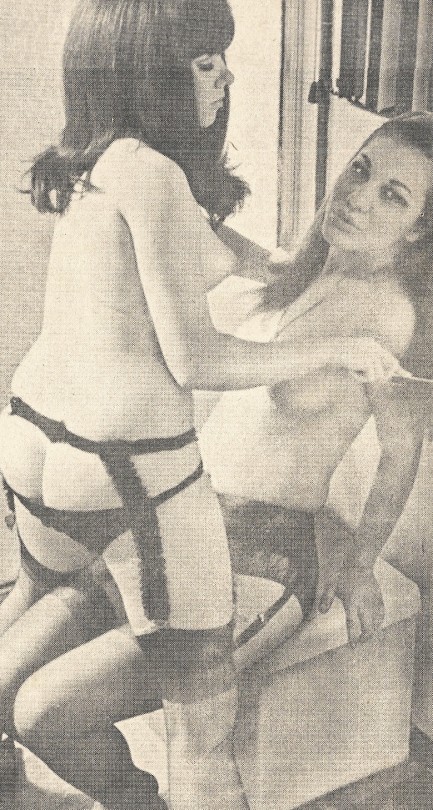
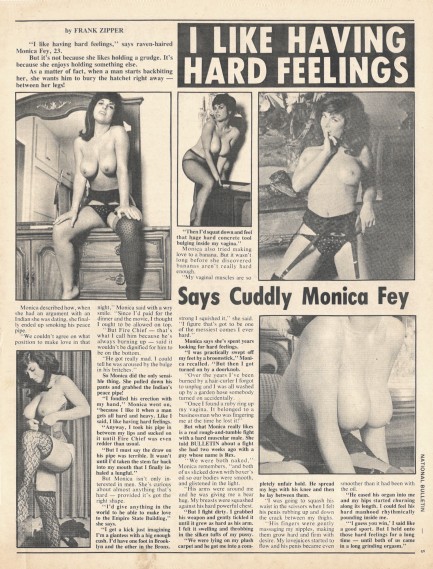

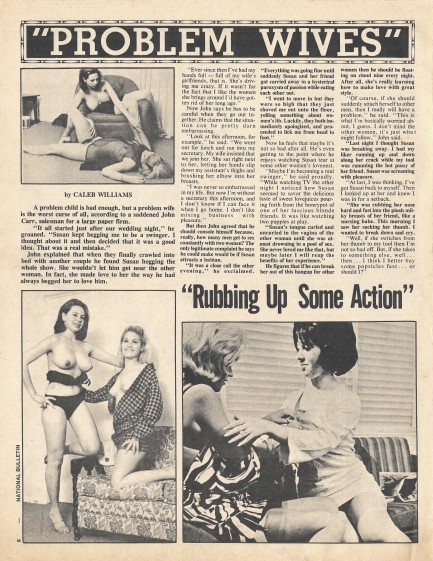
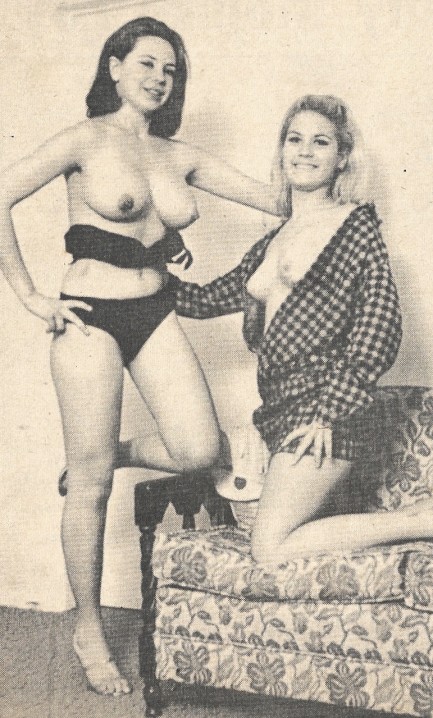
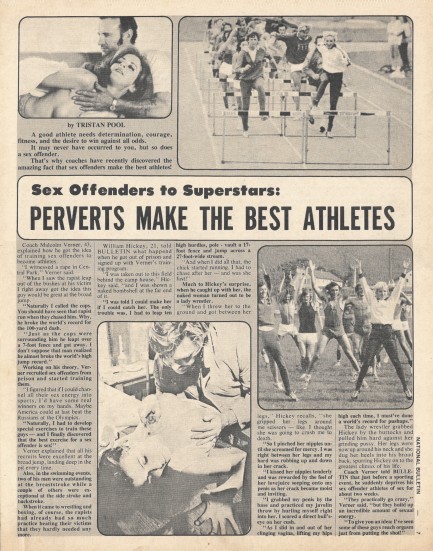
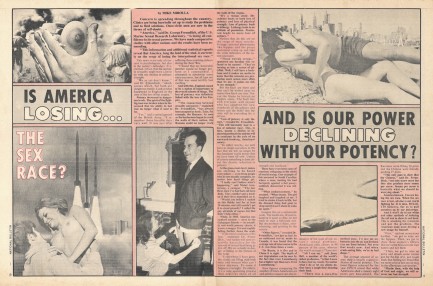
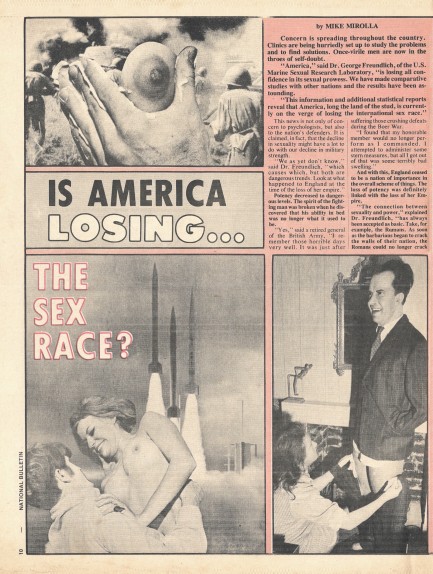

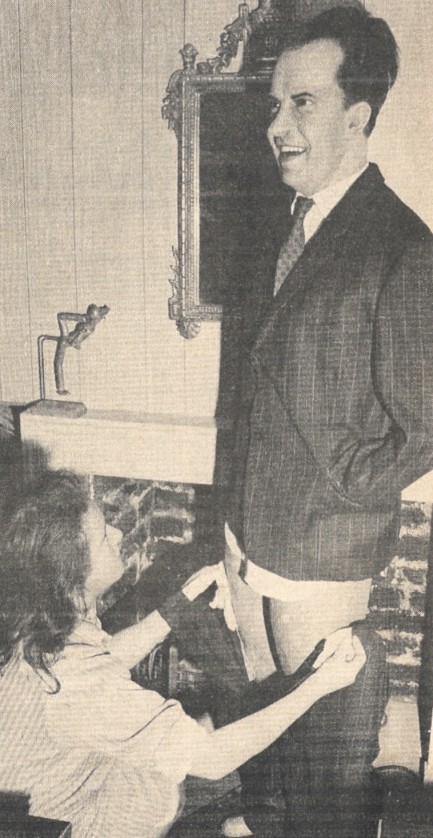
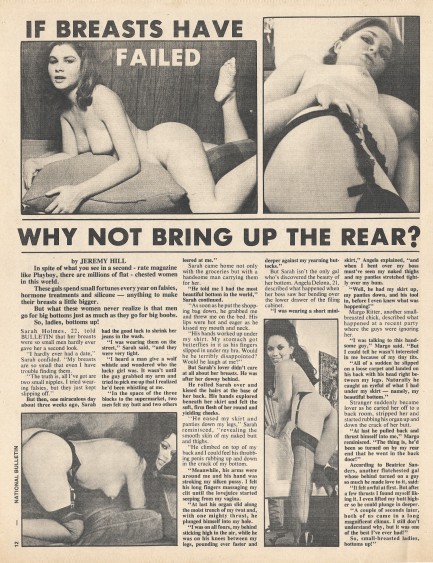
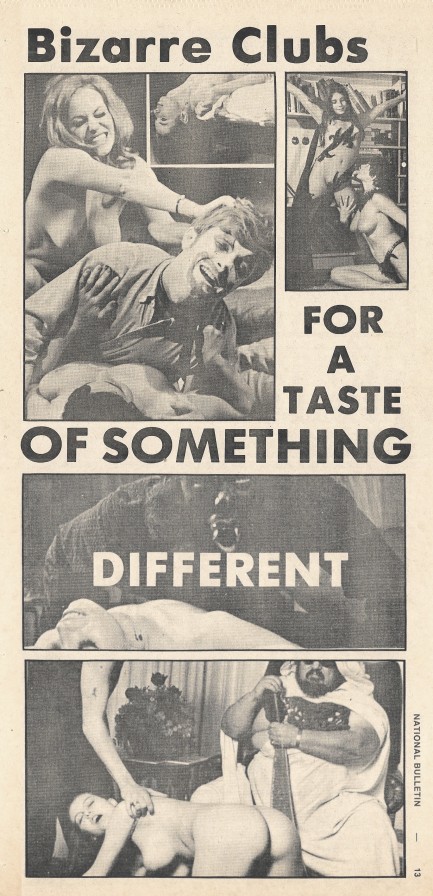
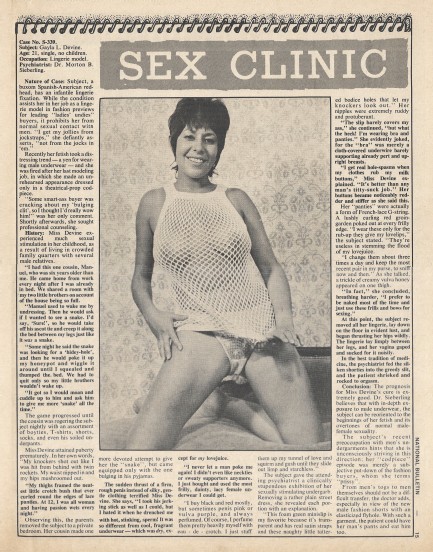
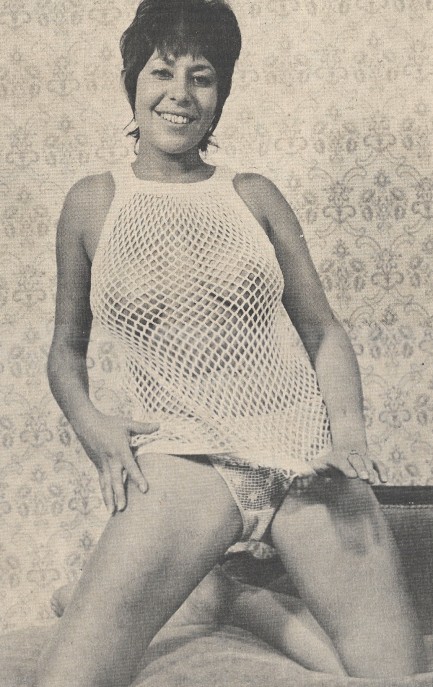
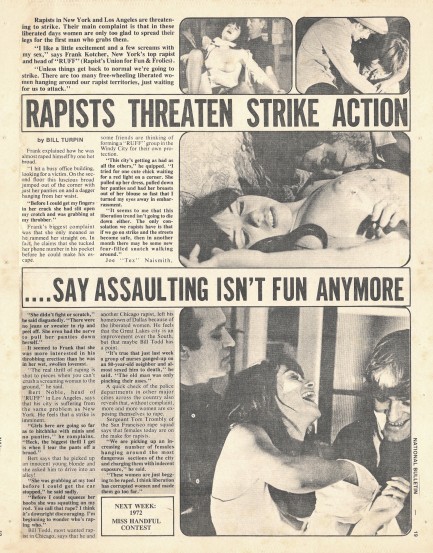
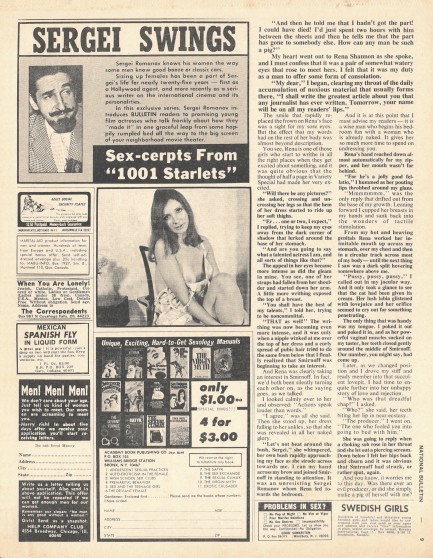
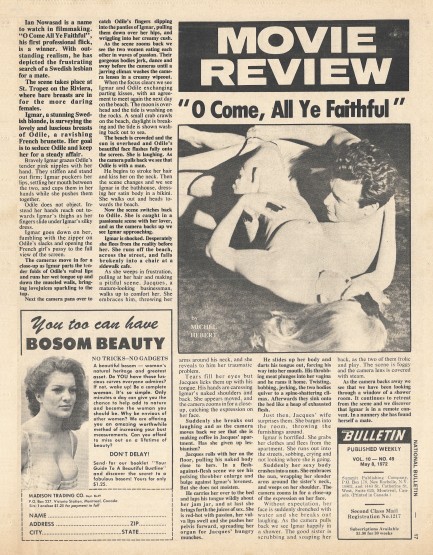
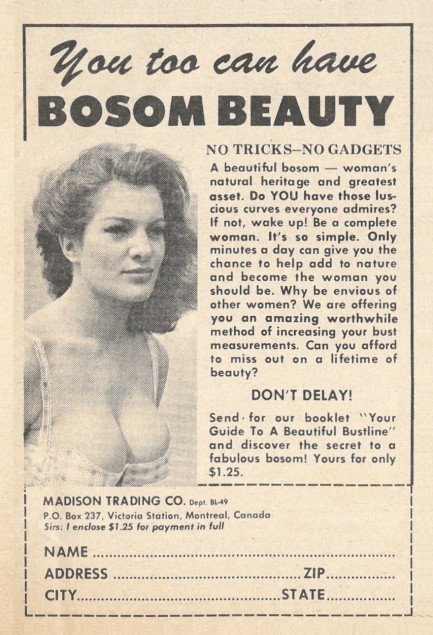
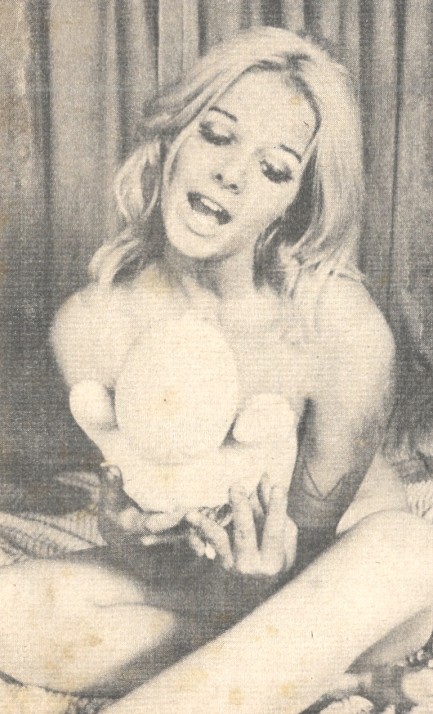
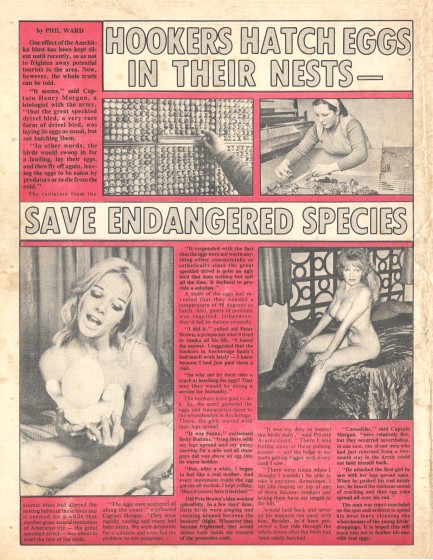
| Vintage Pulp | Nov 10 2021 |

Her story is more dream than nightmare, but that's why it's fiction.
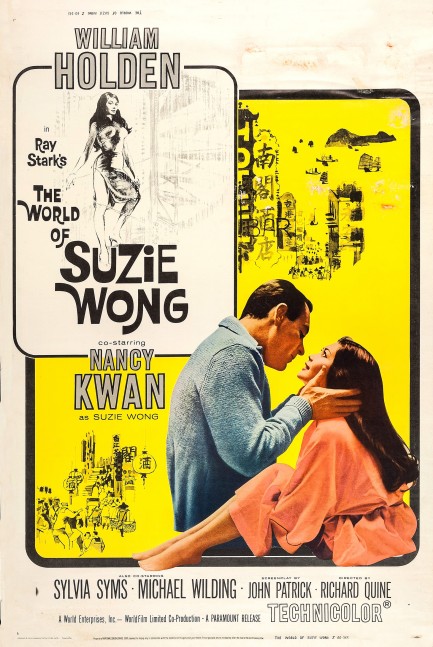
The World of Suzie Wong was the definition of a polarizing film, generally liked by audiences, but often reviled by social observers. For the former group it was just entertainment, a risqué Cinderella fantasy. For the latter group, it was an exercise in cinematic irresponsibility. Few filmmakers have been interested in exploring the human trafficking, physical and psychological abuse, drugs, and destroyed futures that predominate prostitution, but that's no surprise—filmmaking is about moneymaking, and who'd normally go see a movie that was such a downer? While it's true that 2015's Tangerine was acclaimed, it was also shot on three iPhones. Its director has moved on to bigger budgets because he wants to make money too. So let's first of all accept Suzie Wong for what it is: a mainstream film exploring the idea of a rare type of prostitute—the one clearly destined for a better life.
The idea isn't actually so outlandish. Our personal experience has taught us that there are all kinds of hookers. In Brazil, some do it for two weeks bracketing Carnival and make more money than they do working their regular jobs the rest of the year. They don't consider themselves to be prostitutes. They consider themselves to be modern-minded and smart. When PSGP worked at Playboy he was aware of models (anecdotally) and porn actresses (definitely) who did it when they had money troubles. There are plenty of men who'll pay to sleep with his favorite centerfold or porn star, and the money she earns is all hers—none goes to an agent or grifter boyfriend. Models were occasionally invited to certain Middle Eastern oil states and were paid many thousands of dollars per week just to attend swank social occasions and be friendly. The friendliest—interpret that how you wish—would be welcome to stay for months and earn gifts, while the less friendly ones quickly would be shipped out. The point is there are all types.
So while people who hate Suzie Wong are correct that a depiction of prostitution that doesn't explore the typical reality reinforces a false narrative about what is a dirty and dangerous job, the movie is simply a piece of entertainment—and has the right to be. It's no more about real prostitution than Raiders of the Lost Ark is about real archaeology. You'll have to gloss over its imperialist ethnic snobbery too. But if you choose to cross the disbelief suspension bridge, it's a pretty entertaining flick, a drama about an American artist in Hong Kong played by William Holden who meets a local prostitute played by Nancy Kwan, asks her to model for him, and over the course of their increasingly fruitful artistic collaboration finds himself drawn to her. Kwan makes no secret of the fact that she immediately has feelings for Holden, but he resists—not forever, obviously. At that point the difficult question of whether they can actually make a life together—or should even try—is what the plot explores.
Suzie Wong's gimmick of a hooker's love completing a man who's lonely or adrift has been used in films such as Irma la Douce, Night Shift, and Pretty Woman, and audiences responded favorably because, at their core, all those films are romances. But there's more to Suzie Wong than just its sooty Cinderella aspects. At a time of still-rigid ideas about female purity, it asked male viewers to consider the possibility that the number of men a woman sleeps with is immaterial. So in that sense it's a forward thinking film—something usually forgotten by its critics. The source novel by Richard Mason is probably more nuanced, but we haven't read it. We do know, however, that he wrote it after staying at the Luk Kwok Hotel in Hong Kong, which was a brothel. So maybe he learned a little something that gave his book—and the film—a bit more verité than people generally suspect. When you include its great exteriors and sets, and Kwan herself in a starmaking role, the result is exotic, emotional, and at times uplifting. The World of Suzie Wong premiered in the U.S. today in 1960. See more promo images here and here.
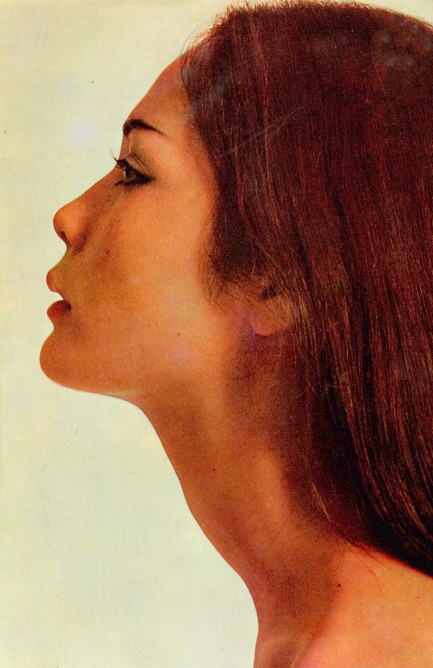
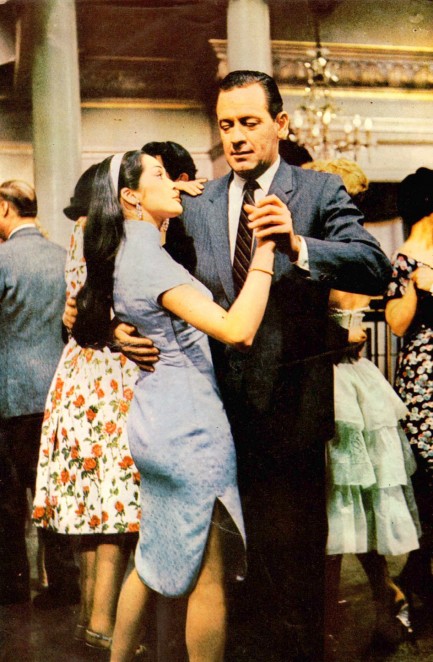
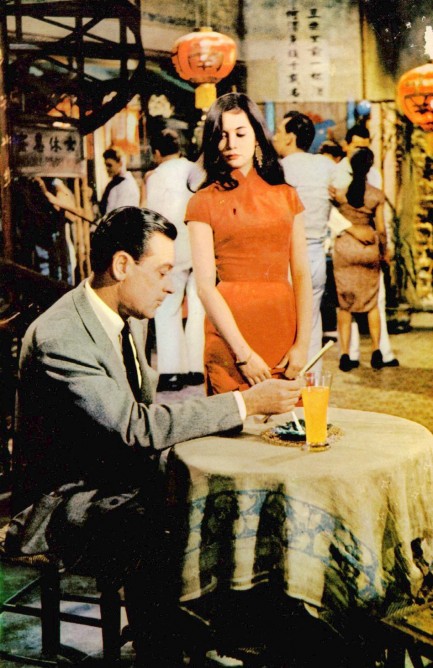
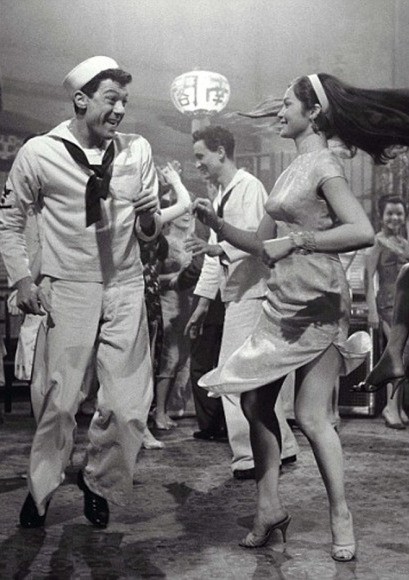
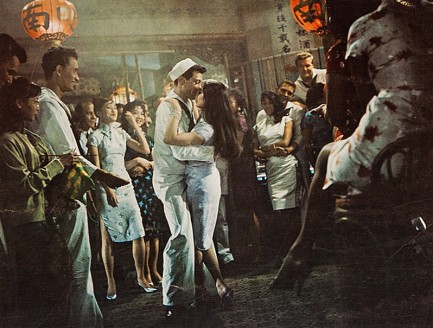
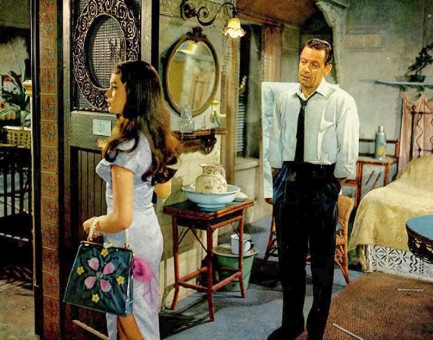
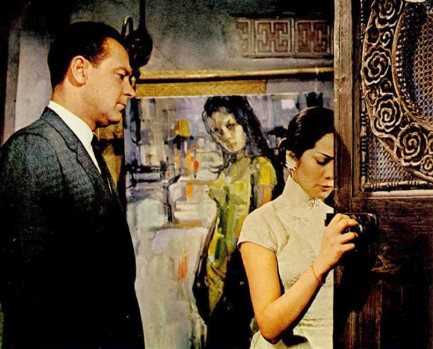
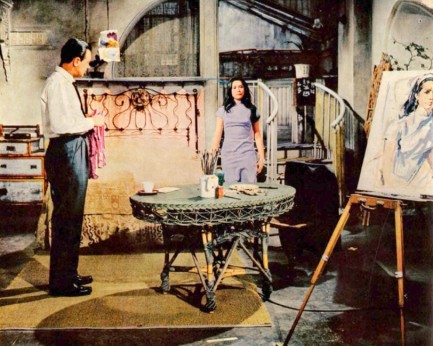
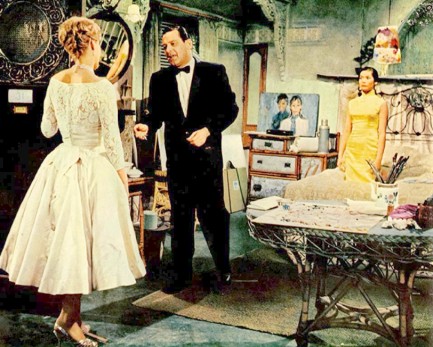

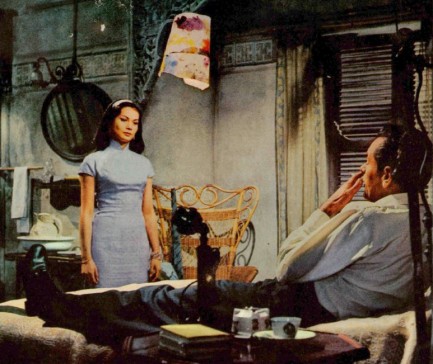
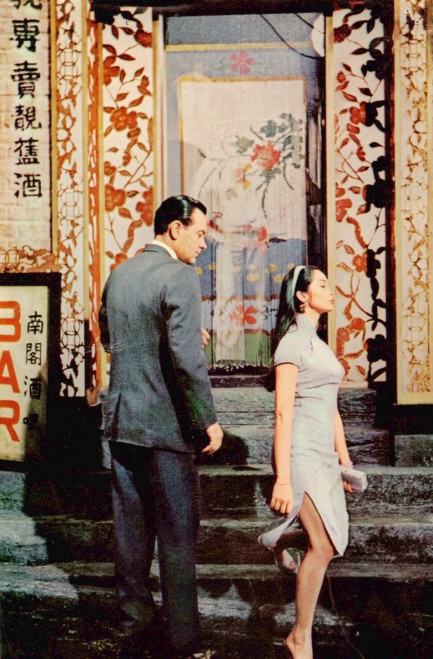
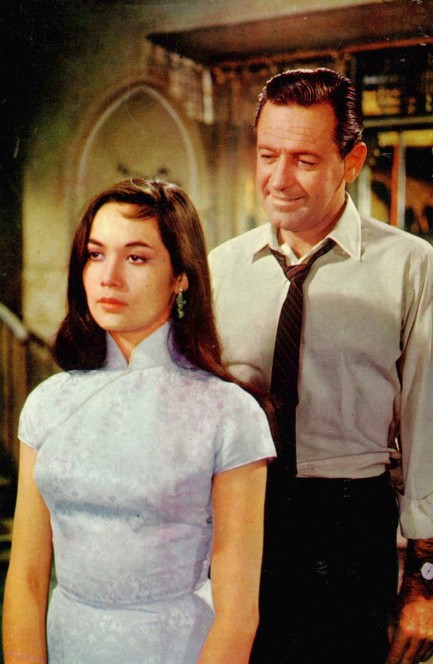
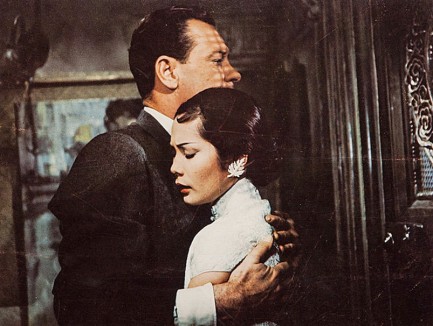
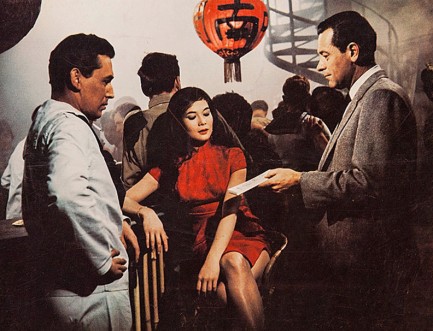
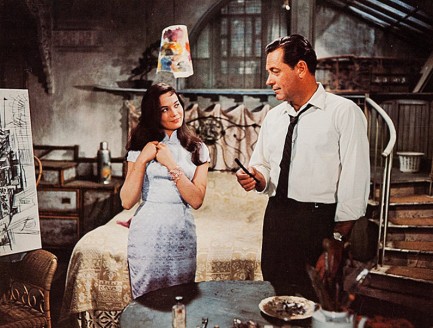
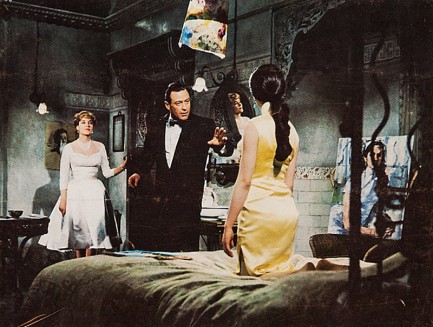
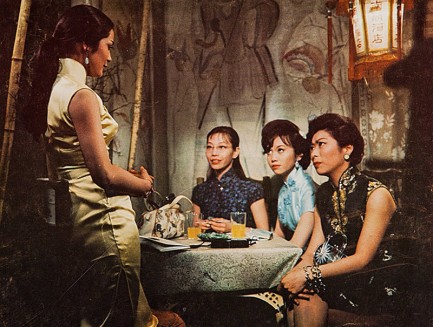
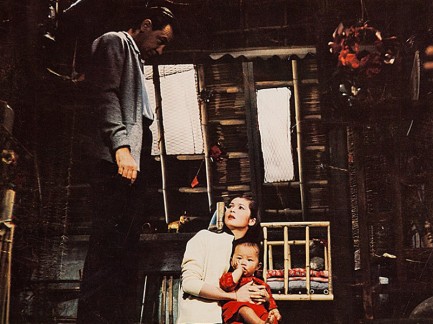
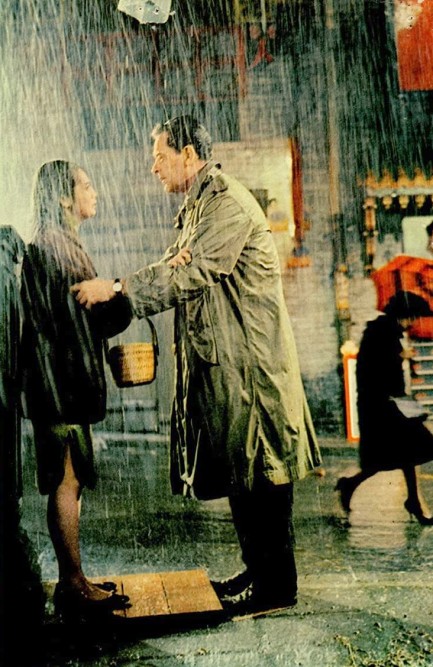






















| Vintage Pulp | Oct 22 2021 |

They say you can't buy love, but you just have to know where to shop.
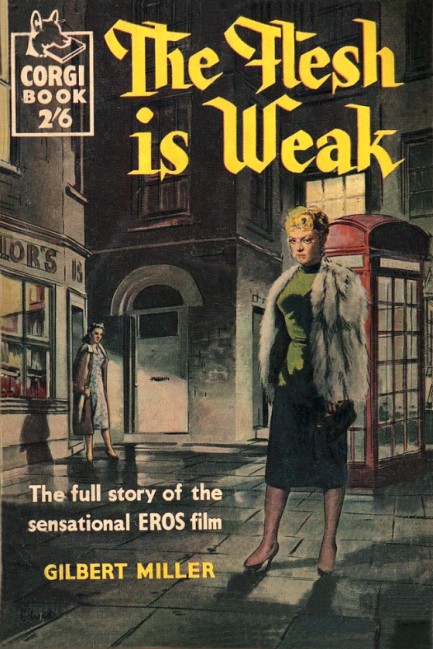
Above: a striking cover for Gilbert Miller's novelization of the 1957 movie The Flesh Is Weak, which is about how a ring of sex traffickers trick naive women into street prostitution. It stars Milly Vitale, and the painting here by John Richards is a very good likeness of her, despite its cartoonish style. We also like the fur. She must have borrowed it from her pimp. To see our other material on this film just click its keywords below and scroll.
| Femmes Fatales | Aug 28 2021 |

All will be revealed in the end.

In complete contrast to the above photo of a couple of dead guys, here's something life affirming—a photo of Japanese actress Masumi Jun in nothing but a shirt. It was made for her 1974 roman porno movie Gendai shöfu-kö: no shita no uzuki, aka Modern Prostitution: Lust Under a Uniform, and now we see a bit of what's under the uniform. This is the same image as on the cover of the DVD release, but without text and other distractions. The original poster also features Jun in nothing but a shirt. You can see that here.
| Vintage Pulp | Aug 6 2021 |

How do you show your man you love him? Show your love to other men.
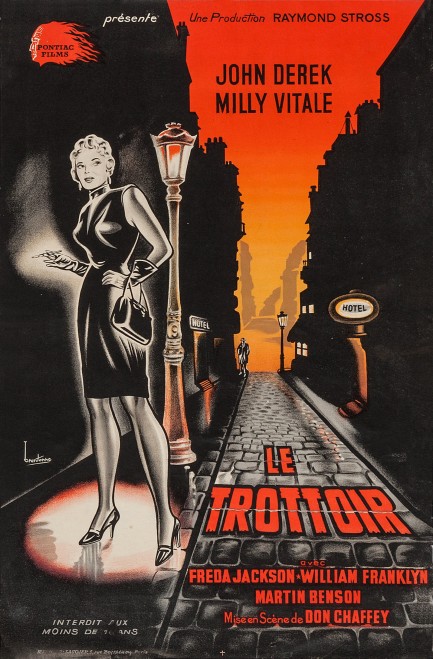
Here's another amazing and framable movie poster, this time for Le trottoir, which was originally made in England as The Flesh Is Weak. The art is by René Brantonne, who typically illustrated book covers, such as here and here. This is stylish work, very different from what we've seen him do before. It's cartoonish, but captures the mood of the film, an urban drama starring John Derek. Yes, that John Derek, the one who— Or has he been forgotten already? We'll reacquaint you. Derek was an actor, photographer, screenwriter, and director, but he's best known as a sort of Svengali who directed his fourth wife Bo Derek in several erotic films in which male actors got to squeeze and lick her soft parts. In 1984's Bolero he shot Bo in three love scenes, one of which made viewers wonder if there was more than acting involved. That's unlikely, but even so, actual penetration was about the only thing missing, which makes John Derek a different kind of husband indeed.
His partnership with Bo in using her body to make money is even more interesting considering the subject matter of The Flesh Is Weak. He plays London agent who meets naive Milly Vitale and convinces her to attempt resolving his debt problems by selling her womanly favors. Of course, he has no debt problems, and he's no agent—he's a pimp, and chose Vitale to convert to prostitution. She ends up tricked into selling herself because she's in love, and though for some readers that surely seems impossible to comprehend, we read Iceberg Slim's autobiographical Pimp some years back and he confirmed from a firsthand perspective that love was what he often used as a lever. It's hard to imagine but true. And its pretty sad, even in the sanitized version presented in The Flesh Is Weak. Is it worth watching? There's no need to clear your schedule, but overall it's pretty good. There's no known French release date, but it had its world premiere in London today in 1957.
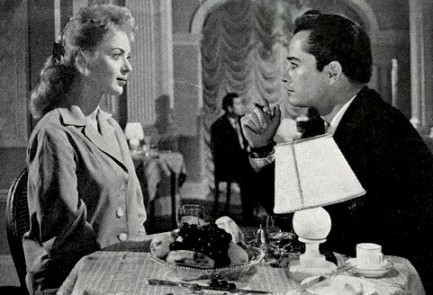
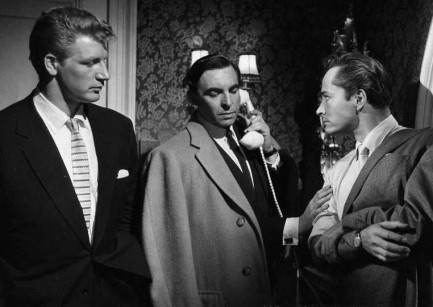
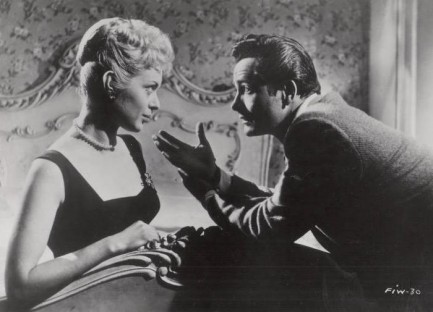
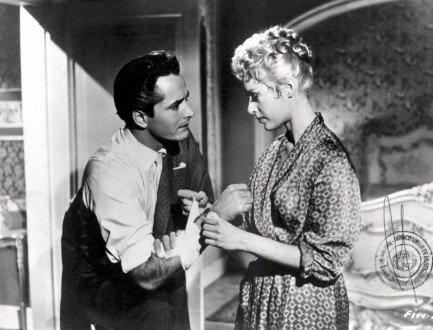
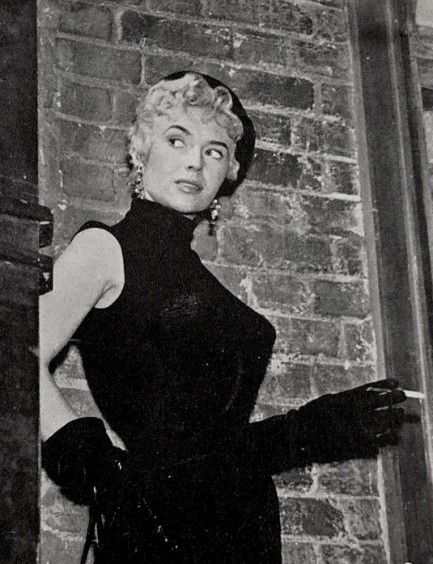
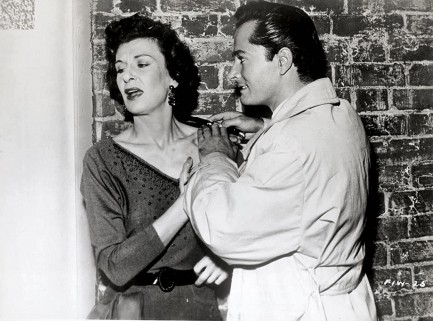
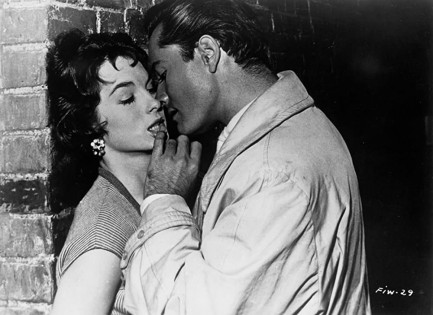
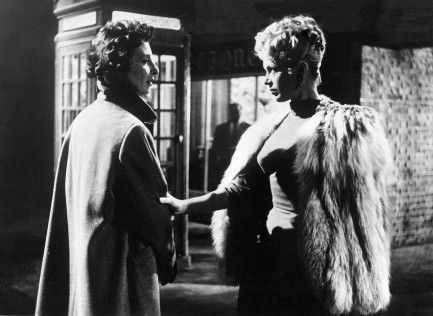

| Vintage Pulp | Feb 12 2021 |

It's a slippery slope down to the gutter—especially when you're pushed.
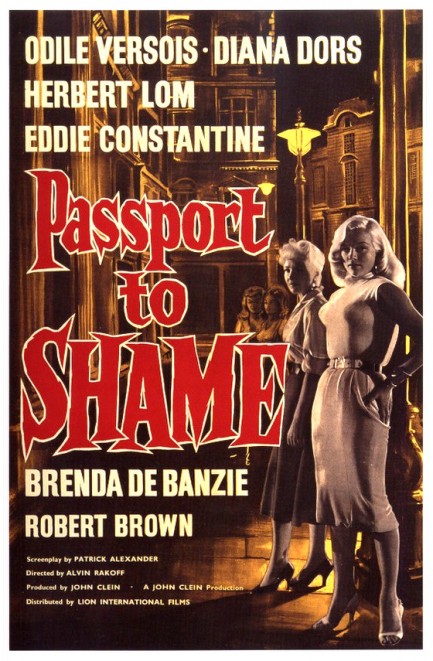
This cool British poster was made to promote Passport To Shame, a vice scare flick, a cautionary tale for women about how easy it is to end up a hooker. A number of such films were made back in the day. This one even has some authority figure or other introducing the film in stentorian tones, telling how a dead end life of vice is just one bad decision away. After the oratory, we see how the leaders of a prostitution ring use labyrinthine scams to force women onto the stroll. They frame Odile Versois into debt, lure her from France to London, and convince her she needs a work permit that she can only obtain by marrying a Brit.
The “Brit” is U.S. actor Eddie Constantine, who's being scammed to participate, also by being tricked into debt. We were baffled as to why he needed at all, but hey, it's in the script, so we went with it. The most curious part of the gang's scheme is that they own a boarding house connected to an adjacent boarding house via a secret door. We suppose this portal makes it easy for the ringleaders to get back and forth, but Odile, duly installed in the legit boarding house, finds the secret door to Sodom with the help of her inquisitive kitten, sees all the hookers hooking, and realizes she's been had.
She's going to be had in a different way by multiple men if she can't get out, but it isn't easy. Her keepers threaten her, starve her, and even drug her, which leads to a hallucinatory Spellbound-style sequence in which the addled Odile sees the literal pits of hell filled with half naked guys waiting to ravish her. Yup—she's in deep shit. But somewhere out there Constantine, her sham husband, who agreed to the marriage assuming Odile knew what she was getting into, realizes she's actually a naive young thing in need of help.
Of course the main selling point for film studio United Co-Productions was Diana Dors, an interesting actress, and an outsize personality in real life. Even though she's second billed, and probably third in screen minutes, she gets pole position on the poster because she was who audiences wanted to see. She plays a jaded prostie named Vicki, also in the game against her will, held by the cruelest of means. Her character has a pivotal part in how this drama turns out, but you'll have to watch to movie to find out what that is. We recommend it. Passport To Shame premiered in the UK today in 1959.
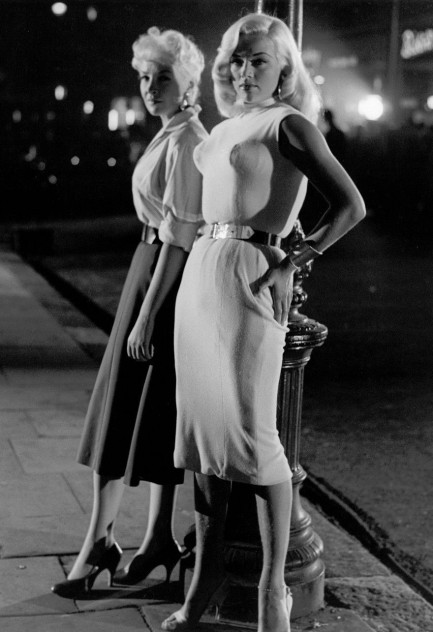
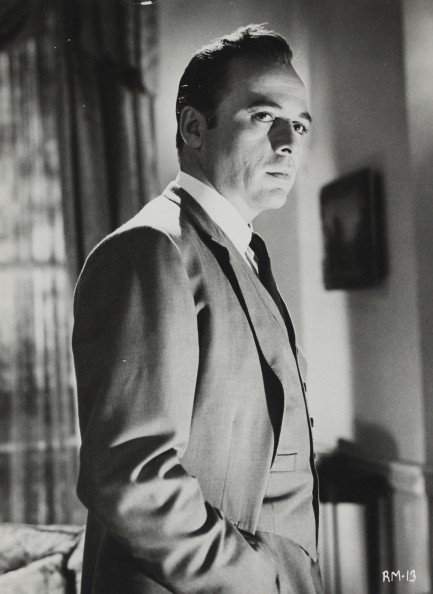
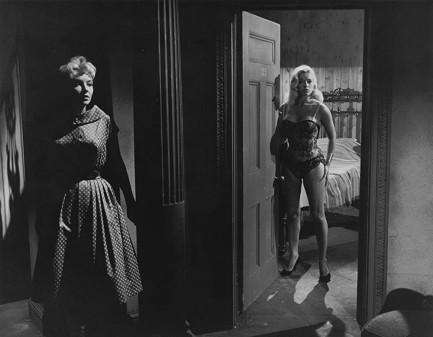

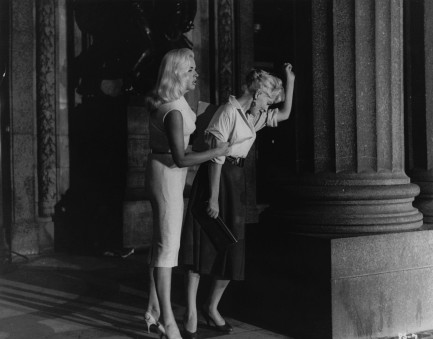
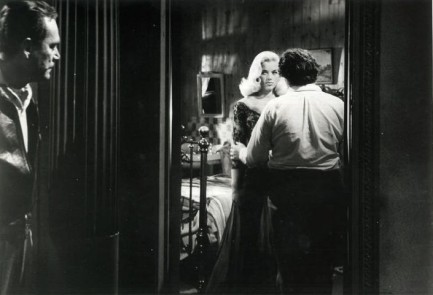
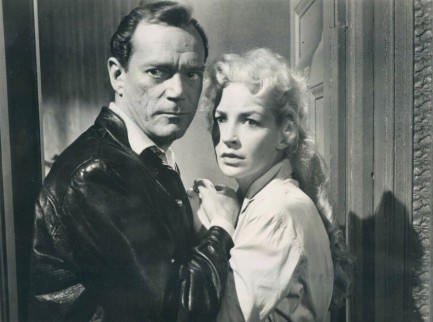
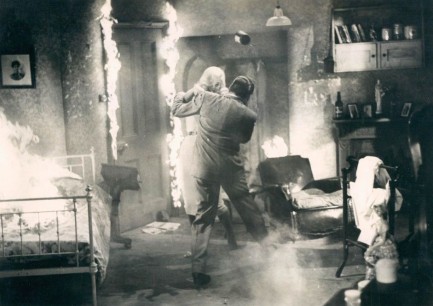
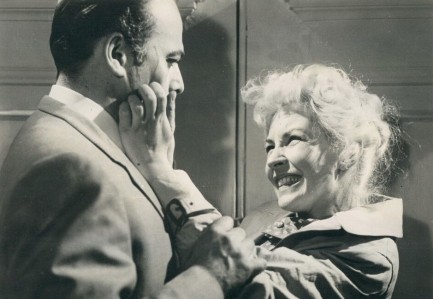
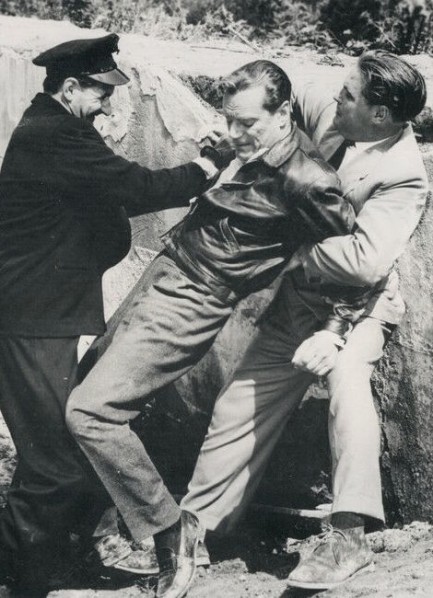
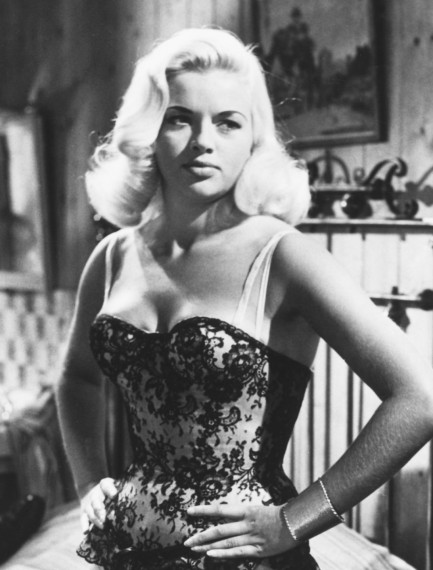
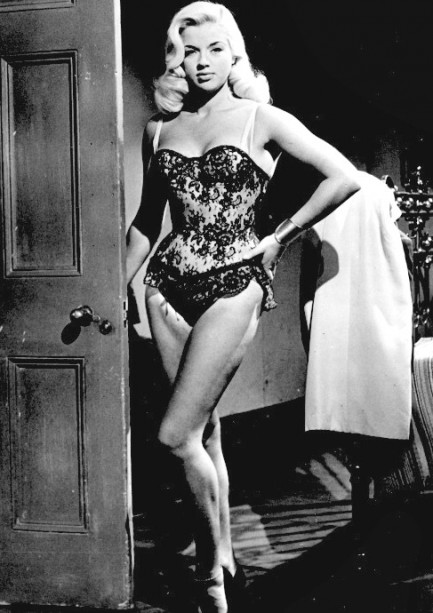
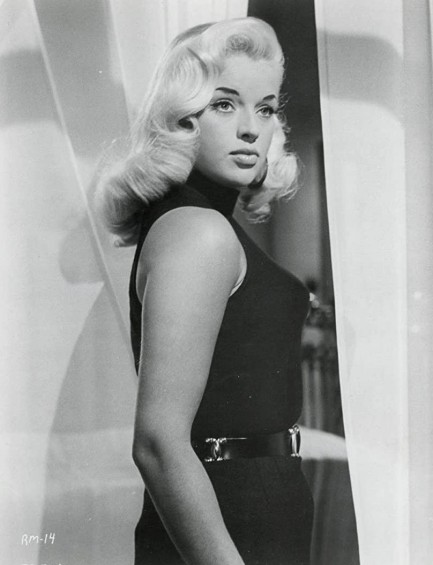
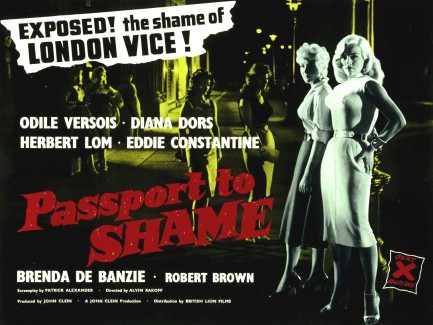














| Vintage Pulp | Jan 30 2021 |

Headquarters, my gas mask has failed! I'm throwing a grenade! How the hell does this thing work? Over!
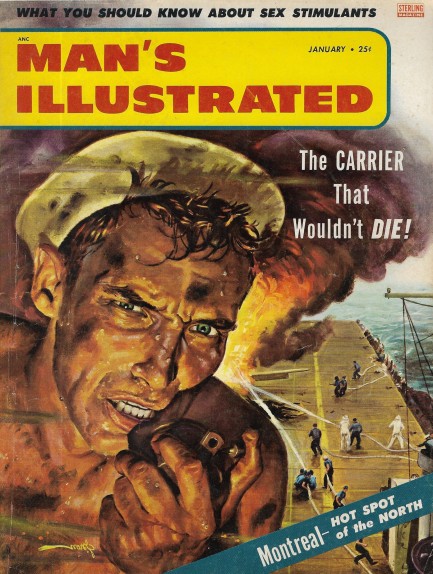
George Gross art fronts this January 1956 issue of Hanro Corp's bi-monthy magazine Man's Illustrated. It's an interesting image, but here's where we show our age, or lack of industrial background, or something, because we have no idea what the hell Mr. Flinty Eyes on the cover is holding. Hand grenade? Gas mask? Some kind of steampunk style microphone? Combo of all three? Well, not knowing is not a problem. We still like the image.
It's been a while since we featured this magazine, but we're glad to get back to it because inside this issue there's art from Walter Popp and Rudolph Belarski, and a nice feature on Rear Window actress Georgine Darcy, who we've talked about once or twice before. As far as written content, you get plenty of war and hunting action, of course, but we were drawn to, “The Hottest Town North of the Border,” an investigative piece by journo B.W. Von Block. What town is he talking about? Montreal, which apparently back in ’56 was the one of the best places in the world to get your ashes hauled.
These type of stories, which were standard in old men's magazines, always give us a laugh because with their breathless focus on subjects like legal prostitution, nude beaches, and dusk-to-dawn nightclubs they show how repressed the U.S. was compared to so much of the world. It still is, actually. Trust us, we've been around, lived abroad for a long time now, and greatly enjoyed the more permissive societies in which we've resided—including our current one.
The U.S. does have many good points, though, one of which is that no country's inhabitants preserve its popular media so prodigiously—which is why we have so many vintage books and magazines to share on Pulp Intl. in the first place. We've pondered many times why Americans hoard more than other cultures and we've finally come up with an answer: garages. Two thirds of Americans have garages. So here's to American garages. They give millions the joy of being their own museum curators.
